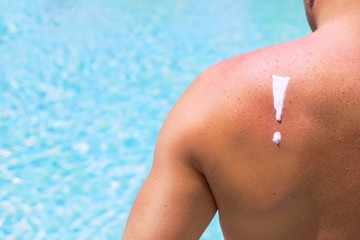Many medicines make you sensitive to the sun
U.S. Food and Drug Administration (FDA)
Sun Protection Factor
When shopping for a sunscreen, consumers are faced with many choices, which include the sun protection factor (SPF) value, a measure of how much sunlight (UV radiation) is needed to develop sunburn after a sunscreen has been applied, compared to the amount of UV radiation required to develop sunburn on unprotected skin. UV radiation consists of both UVA and UVB radiation. SPF is primarily an indicator of protection from UVB radiation. The higher the SPF, the greater the protection from UVB radiation, and so the greater the sunburn protection. If a product is labeled as providing broad spectrum protection, this means it also provides protection against the sun’s UVA radiation.
It is important to know that SPF does not tell you how long you can be in the sun without getting sunburn. SPF does not mean, that if you normally burn in 1 hour and you apply an SPF 8 sunscreen, it will take 8 hours for you to burn. Wrong! Instead, SPF tells you the amount of sunburn protection from UV radiation that is provided by sunscreens when they are used as directed – SPF is not burn protection time.
Several things can affect the amount of UV radiation exposure you will experience when you go out in the sun:
• Time of Day
• Season
• Geographic Location
• Altitude
Weather Conditions (Cloudy Day versus Sunny Day)
For example, a person spending 15 minutes in the sun at noon in Boston without sunscreen may not sunburn, but that same person without sunscreen in Miami could likely burn after spending 15 minutes in the sun, because of the higher amount of UV radiation exposure in the Miami geographic location.
Skin complexion, amount of sunscreen applied, and how often you reapply sunscreen can also affect the level of UV radiation exposure you experience. In order for a sunscreen to be effective, it’s important that it be applied as directed, and reapplied as directed and needed, based on physical activity. Participating in activities like swimming or activities that can promote heavy sweating may require more frequent reapplication.
Remember, SPF does not tell you how long you can be in the sun without getting sunburned. Instead, it’s a measure of the amount of sunburn protection from UV radiation that is provided by sunscreens when they are used as directed.
Fun in the sun can be had all year long — hiking, winter skiing, swimming, or just enjoying the warmth of the sun. However, when taking certain medicines, life in the sun can sometimes be less than fun.
Photosensitivity
Some medicines contain ingredients that may cause photosensitivity — a chemically induced change in the skin. Photosensitivity makes a person sensitive to sunlight and can cause sunburn-like symptoms, a rash or other unwanted side effects. It can be triggered by products applied to the skin or medicines taken by mouth or injected. There are two types of photosensitivity – photoallergy and phototoxicity.
Photoallergy is an allergic reaction of the skin and may not occur until several days after sun exposure. Phototoxicity, which is more common, is an irritation of the skin and can occur within a few hours of sun exposure. Both types of photosensitivity occur after exposure to ultraviolet light – either natural sunlight or artificial light, such as a tanning booth.
Medicines that Cause Sensitivity to the Sun
There are certain types of medicines that can cause sensitivity to the sun. Some of these include:
• Antibiotics (ciprofloxacin, doxycycline, levofloxacin, ofloxacin, tetracycline, trimethoprim)
• Antifungals (flucytosine, griseofulvin, voricanozole)
• Antihistamines (cetirizine, diphenhydramine, loratadine, promethazine, cyproheptadine)
• Cholesterol-lowering drugs (simvastatin, atorvastatin, lovastatin, pravastatin)
• Diuretics (thiazide diuretics: hydrochlorothiazide, chlorthalidone, chlorothiazide.; other diuretics: furosemide and triamterene)
• Non-steroidal anti-inflammatory drugs (ibuprofen, naproxen, celecoxib, piroxicam, ketoprofen)
• Oral contraceptives and estrogens
• Phenothiazines (tranquilizers, anti-emetics: examples, chlorpromazine, fluphenazine, promethazine, thioridazine, prochloroperazine)
• Psoralens (methoxsalen, trioxsalen)
• Retinoids (acitretin, isotretinoin)
• Sulfonamides (acetazolamide, sulfadiazine, sulfamethizole, sulfamethoxazole, sulfapyridine, sulfasalazine, sulfasoxazole)
• Sulfonylureas for type 2 diabetes (glipizide, glyburide)
• Alpha-hydroxy acids (AHAs) in cosmetics
Not all people who take or use the medicines mentioned will have a reaction. Also, if you experience a reaction on one occasion, it does not mean that you are guaranteed to have a reaction if you use the product again.
Reduce Reaction Risk
If you have concerns about developing a reaction, try to reduce your risk:
• When outside, seek shade, especially between 10:00 a.m. and 2:00 p.m. – some organizations recommend as late as 4:00 p.m. Keep in mind that the sun’s rays may be stronger when reflected off water, sand and snow.
• Wear long-sleeved shirts, pants, sunglasses, and broad-brimmed hats to limit sun exposure.
• Use a broad sunscreen regularly and as directed. Broad-spectrum sunscreens provide protection against ultraviolet A (UVA) and ultraviolet B (UVB) radiation. An SPF 15 is the minimum number needed to provide measurable protection; however, a sunscreen with an SPF value of 30 or higher is recommended. Rarely, some sunscreen ingredients can cause photosensitivity themselves.
If you have questions about your medications and the possibility of a photosensitivity, contact your health-care professional or pharmacists.
Taking a few precautions can help limit your risk of photosensitivity and keep the sun shining on your fun.
